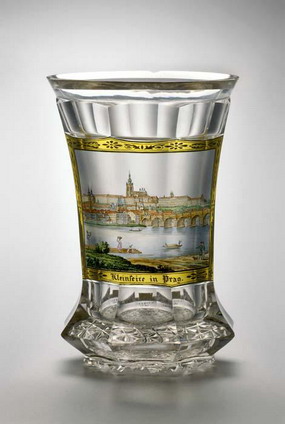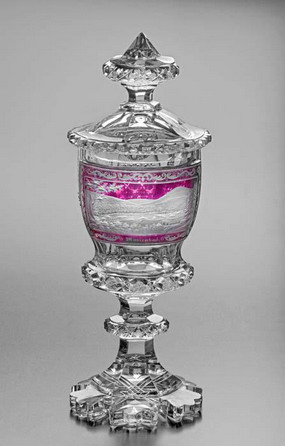|

113
画有布拉格城堡和小镇莱塞(布拉格小城)的大酒杯
波希米亚,19世纪第二个25年
无色透明玻璃,刻花,透明色料彩绘,描金;高12.4 cm
铭文: Kleinseite in Prag
编号 79 921
1963年通过所有权转让获得
Beaker with a view of Prague Castle and the Lesser Town (Malá Strana)
Bohemia, 2nd quarter of 19th century
Colourless glass, cut, painted in transparent colours; H. 12.4 cm
Inscription: Kleinseite in Prag
Inv. no. 79?921
Acquired in 1963 by ownership transfer
HB

114
刻有玛丽亚温泉市风景的有盖高脚杯
波希米亚,1845
无色透明玻璃,部分染成桃红色,刻花(诺伊韦尔特),雕花(西波希米亚);高35 cm
编号 45 443
1958年购自布拉格的阿提亚公司
这件高脚杯上刻着玛丽亚温泉市的风景和铭文“od Ant. V. Lebedi w roku 1845”(英文即“by Ant. V. Lebedi in 1845”)。“Ant. V. Lebedi”指安东宁·文森斯·莱贝达(1795–1857),是19世纪上半叶一家著名的狩猎火器和体育射击火器生产商。这件酒杯可能是莱贝达公司回馈一位重要商业伙伴的礼品。
Covered goblet with a view of Mariensbad (Mariánské Lázně)
Bohemia, 1845
Colourless glass, partially rosaline-stained, cut (Neuwelt), engraved (Western Bohemia), H. 35 cm
Inv. no. 45?443
Purchased in 1958 from Artia, Prague
The goblet with a view of Mariensbad has an inscription on the lid that reads: “od Ant. V. Lebedi w roku 1845” (“by Ant. V. Lebedi in 1845”). It refers to Antonín Vincenc Lebeda (1795–1857), a prominent Prague manufacturer of hunting and sport shooting firearms of the first half of the 19th century. The goblet could have been a gift for one of Lebeda’s leading trade partners.
HB
115
大酒杯
北波希米亚(克尔科诺谢山脉),约1820年
无色透明玻璃,刻花,雕花(库格勒雕刻法);高11.5 cm
编号 25 435
1948年购自布拉格的V·霍热什拍卖会
库格勒雕刻法是介于车刻和琢磨之间的一种工艺,也可以说是同时使用两种技法的工艺。这种工艺形成于波希米亚帝国风格时期,主要集中于克尔科诺谢山脉,那里的雕刻师把巴洛克传统的人像浮雕工艺改良成高浮雕。库格勒雕刻法复杂而且成本高昂,有时需要去掉玻璃原重的一半才能营造理想的视觉效果。用这种方法创作的作品既费时又费力。
Beaker
Northern Bohemia (Krkono?e Mountains), c. 1820
Colourless glass, cut, engraved (Kuglergraveurarbeit); H. 11.5 cm
Inv. no. 25?435
Purchased in 1940 at the V. Ho?ej? Auction, Prague
Kuglergraveurarbeit is a term designating a decorative technique that is on the borderline between the cutting and engraving methods, or rather that uses the two methods in close symbiosis. This form of decoration developed in Bohemia during the Empire Style period, especially in the Krkono?e Mountains region, where engravers enhanced the Baroque glass-refining tradition of cameo carving in high relief. The use of this type of decoration was by no means simple or cheap; sometimes the weight of the object thus decorated was reduced by half in the process of cutting away the excess glass. The creation of the required design was time-and energy-consuming.
JSch
116
一对油瓶和醋瓶
北波希米亚,海达,弗里德里克·艾格曼工坊绘制,约1820年
乳白玻璃,珐琅彩绘;高19.8 cm
编号 68 867
1966年购自布拉格的阿提亚公司
Matching oil and vinegar cruets
Northern Bohemia, Haida, decorated in Friedrich Egermann’s workshop, c. 1820
Milk glass, painted in enamels; H. 19.8 cm
Inv. no. 68?867
Purchased in 1966 from Artia, Prague
JSch
117
花瓶
北波希米亚,海达,弗里德里克·艾格曼工坊绘制, 1820年后
浅蓝色不透明玻璃,刻花,绘白色珐琅彩;高23 cm
编号 17 763
1932年由斯图加特的古斯塔夫E.帕兹奥瑞克捐赠
弗里德里克·艾格曼(1777-1864)是一位著名的玻璃工艺家,开发了许多种新式玻璃装饰工艺(黄、红染色玻璃及宝石玻璃),同时他也擅长玻璃绘画。最初他在捷克利帕的布兰斯科(原名:波希米亚利帕的布洛顿多夫)工作,1820年后迁居海达(诺维博尔)。艾格曼的作品对迈森画瓷具有启迪意义。他除了善于精细的黑色画珐琅外,还在乳白玻璃板上创作珐琅彩人物,这些画珐琅玻璃板被用于镶嵌镜框。他做的浅蓝色不透明仿古玻璃瓶,其表面或磨砂或光亮,也颇受欢迎。
Vase
Northern Bohemia, Haida, decorated in Friedrich Egermann’s workshop, after 1820
Light blue opaque glass, cut, painted in white enamel; H. 23 cm
Inv. no. 17?763
Donated in 1932 by Gustav E. Pazaurek, Sttutgart
Friedrich Egermann (1777–1864) was a prominent glass technologist and inventor of various new decorative techniques (yellow and red stains, lithyalin glass). He also specialized in painted glass. He was initially active in Polevsko u ?eské Lípy (Blottendorf bei B?hmische Leipa) and later, from 1820, in Haida (Novy Bor). Egermann’s works attest to his inspiration in contemporary Meissen painted porcelain. Apart from his delicate Schwarzlot paintings, he painted milk glass plaques with figurative motifs in coloured enamels, which served as decorative elements on wooden mirror frames. He is also admired for his vases made in matte or clear, opaque light-blue glass of antiquizing forms.
JSch
118
带盖子的糖缸,嵌莫扎特肖像
北波希米亚,诺伊维尔特,约1828年
无色透明玻璃,嵌瓷,刻花;高17 cm
编号 12 320
1911年购自布拉格的施密特。
比德迈时期最大成就之一就是在玻璃上镶嵌瓷像。继法国和英国掌握该工艺几年以后,即在19世纪20年代早期,诺伊维尔特的玻璃厂也掌握了这一复杂工艺。当时的厂长约翰·波尔直接从法国进口瓷像所需的瓷料。嵌瓷纹样有的是同时代或历史上的名人肖像,如耶稣基督、圣母玛利亚和圣徒等,有的是花卉纹饰,还有的是纹章符号,不一而足。
Covered sugar bowl with a portrait of W. A. Mozart
Northern Bohemia, Neuwelt, c. 1828
Colourless glass with embedded porcelain paste, cut; H. 17 cm
Inv. no. 12?320
Purchased in 1911 from Schmidt, Prague
Artefacts with encased small ornamental objects of porcelainlike material (incrustations, also known as sulphides) were among the most distinctive glass achievements of the Biedermeier period. The Neuwelt (Novy Svět) glassworks mastered this intricate technique in the early 1820s, only a few years after the French and English glass manufacturers. Johann Pohl, the then head of the Neuwelt glassworks imported the pastes directly from France. The embedded decoration featured portraits of distinguished personalities (both contemporary and historical), figures of Jesus Christ, the Madonna and saints, as well as floral designs and heraldic symbols (insignia and coats of arms), to name a few.
JSch
119
嵌拿破仑头像的酒杯
法国,巴卡拉公司出品,约1830年
无色透明玻璃,嵌瓷,刻花;高8 cm
编号 68 520
1965年布拉格的W. 马库斯捐赠
Beaker with a portrait of Napoleon
France, Bacarrat, c. 1830
Colourless glass with embedded porcelain paste, cut; H. 8 cm
Inv. no. 68?520
Donated in 1965 by W. Markus, Prague
JSch
120
嵌圣母圣子像的座子
北波希米亚,诺伊韦尔特,约1832年
无色透明玻璃,嵌瓷,刻花;高29 cm
编号 30 793
1949年购自布拉格的一家古董拍卖会
嵌瓷玻璃座子在同类产品中产地最多。它们本质上是祷告用品,其外形来源于巴洛克时期的圣骨匣、圣体匣和装饰性十字架。这件玻璃座子很典型,通体装饰精美的车刻花纹。座子上的嵌瓷可能来自法国,因为厂长约翰·波尔偏爱使用法国瓷,而非奥地利本国瓷。
Stand with the Madonna and Child
Northern Bohemia, Novy Svět (Neuwelt), c. 1832
Colourless glass, with embedded porcelain paste, cut; H. 29 cm
Inv. no. 30 793
Purchased in 1949 at the Antikva Auction, Prague
Stands with embedded pastes were among the most widely produced objects of its kind. These were essentially devotional objects derived in form from Baroque reliquaries, monstrances and ornamental crosses. The objects were typically decorated with exquisite, allover cut designs. Porcelainlike pastes of French origin was probably used for this object, which Johann Pohl (the glassworks’ manager) preferred over domestic (i.e. Austrian) pastes.
JSch
121
有盖高脚酒杯
北波希米亚,诺伊韦尔特,约1832年
无色透明玻璃,嵌瓷,刻花;高29 cm
编号 26?277
1949年购自布拉格的古董拍卖会
Covered goblet
Northern Bohemia, Novy Svět (Neuwelt), c. 1832
Colourless glass, with embedded porcelain paste, cut; H. 29 cm
Inv. no. 26?277
Purchased in 1949 at the Antikva Auction, Prague
JSch
122
有盖大酒杯,刻有野猪狩猎场景
北波希米亚,1831年后
无色透明玻璃,刻花(诺伊韦尔特),雕花(位于米斯特罗维采的弗朗茨·安东·百利金工坊),米斯特罗维采德语又名迈斯特斯多夫;高34.5 cm
编号 61 771
1964年购自布拉格的阿提亚公司
Covered beaker engraved with a wild boar hunting scene
Northern Bohemia, after 1831
Colourless glass, cutting (Neuwelt), engraving (Franz Anton Pelikán’s workshop, Mistrovice (Meistersdorf); H. 34.5 cm
Inv. no. 61 771
Purchased in 1964 from the Artia company, Prague
JSch
123
大酒杯
北波希米亚,约1830年
无色透明玻璃,刻花,雕花;高12.5 cm
铭文:Von Deinem Theodor am 13. November 1831
编号 17 592
1932年由斯图加特的古斯塔夫E.帕兹奥瑞克捐赠
Beaker
Northern Bohemia, c. 1830
Colourless glass, cut, engraved; H. 12.5 cm
Inscription: Von Deinem Theodor am 13. November 1831
Inv. no. 17?592
Donated in 1932 by Gustav E. Pazurek, Stuttgart
JSch
124
阿尔弗雷德·温迪施格雷茨亲王圆形胸像
北波希米亚,诺伊韦尔特,19世纪40年代,很可能由弗兰季谢克矿泉镇的多米尼克·比曼于1849年雕刻
无色透明玻璃,刻画,雕花;直径 9.7cm
编号 66 006
1964年通过所有权转让获得(原藏于靠近斯特日布罗的克拉德鲁比城堡)
多米尼克·比曼(1800-1857)出生于克尔科诺谢山脉的诺伊维尔特,是比德迈时期欧洲玻璃雕刻大师,尤以雕刻人像著称。他最初作为玻璃雕刻工在诺伊维尔特的玻璃厂工作。1826年,他前往布拉格学院进行为期一年的学习。学成后成为独立雕刻师,活跃于布拉格雕刻界并语夏天前往弗兰季谢克矿泉镇工作。19世纪40年代中期起,他冬天在舒马瓦山区的新山庄(地名)工作(靠近阿贝尔家族的玻璃厂);在那里他雕刻专门用于镜框的玻璃浮雕。比曼最拿手的绝活还是大量在玻璃酒杯和圆形平面玻璃上雕刻人像。他既能够根据自己画的样稿雕刻,也能看着活体模特现场雕刻。比曼在大多数作品上都会签名,说明他能够意识到自己在玻璃雕刻艺术领域内的出众地位。
Medallion with a portrait of Alfred Windichgr?tz
Northern Bohemia, Novy Svět (Neuwelt), 1840s, engraving by Dominik Biemann, Franti?kovy Lázně, probably 1849
Colourless glass, cut, engraved (marked B.at end of sleeve); diameter 9.7 cm
Inv. no. 66?006
Acquired in 1965 by ownership transfer (originally in the chateau at Kladruby near St?íbro)
Dominik Biemann (1800–1857), a native of Novy Svět (Neuwelt) in the Krkono?e Mountains is regarded as the foremost glass engraver of the Biedermeier period in Europe, particularly for his engraved portraits. Initially, he worked in the Neuwelt glassworks as a glass engraver. In 1826, he enrolled in a one-year course at the Prague Academy. Afterwards, he became independent and was professionally active in Prague and during the summer months in Franti?kovy Lázně. From the mid-1840s he spent his winters in Nová H?rka in the ?umava region (near the Abel family’s glassworks), where he decorated mirror frames with engraved designs. Biemann is best known for his great many portraits engraved on surfaces of beakers or glass medallions. Biemann worked both from his own preparatory drawings and directly from live models. Biemann signed most of his creations, which suggests that he was well aware of his outstanding artistic skills and abilities.
JSch
125
大酒杯
北波希米亚,约1845年
无色透明玻璃,刻花,雕花;高12 cm
编号 50 726
1960年购自布拉格的阿提亚公司
Beaker
Northern Bohemia, c. 1845
Colourless glass, cut, engraved; H. 12 cm
Inv. no. 50?726
Purchased in 1960 from Artia, Prague
JSch
126
刻有G. L.冯·布吕歇尔胸像的高脚酒杯
北波希米亚,约1840年
无色透明玻璃,部分染黄色,刻花(诺伊韦尔特)和雕花;高24.8 cm
标记:August B?hm(奥古斯特·伯姆), Mistrovice (米斯特罗维采又名迈斯特斯多夫)
编号 104 637
奥古斯特·伯姆(1812-1890),一位多才多艺的玻璃雕刻家,一生的大部分时光不在波希米亚。他那生动的、充满活力的雕刻风格把战争场景诠释得淋漓尽致。除此之外,伯姆也擅长雕刻宗教题材、森林小鹿和肖像。这个酒杯上的胸像是维耳斯达特王子、陆军元帅格布哈德·列博莱希特·冯·布吕歇尔,1815年是他协助威灵顿公爵在滑铁卢打败拿破仑。
Goblet with a portrait of G. L. von Blücher
Northern Bohemia, c. 1840
Colourless glass, partially yellow-stained, cut (Neuwelt), engraved; H. 24.8 cm
Marked: August B?hm, Mistrovice (Meistersdorf)
Inv. no. 104?637
August B?hm (1812–1890), a versatile glass engraver, spent a large part of his life outside Bohemia. His dramatic and vivacious style of engraving was put to best use in his battle scene depictions. Apart from his battle engravings, B?hm also specialized in religious motifs, forest interiors with deer, and portraiture. The bowl of this goblet shows the portrait (bust) of Field Marshal Gebhard Leberecht von Blücher, Prince of Wahlstatt, who assisted the Duke of Wellington in defeating Napoleon at Waterloo in 1815.
JSch
127
刻有奔马的有足大酒杯
北波希米亚,诺伊韦尔特,19世纪30年代
桃红色玻璃,刻花和雕花,鎏金;高13 cm
编号 46 526
1958年购自L.阿塔曼斯珈
Footed beaker with an engraving of a horse
Northern Bohemia, Novy Svět (Neuwelt), 1830s
Rosaline glass, cut, engraved, gilded; H. 13 cm
Inv. no. 46?526
Purchased in 1958 from L. Attamanská
JSch
128
饰有首字母“JH”的有柄大酒杯
北波希米亚,诺伊韦尔特,约1835年
桃红色和无色透明玻璃,刻花和雕花,鎏金;高15 cm
编号95 661
1988年购自布拉格的索卢娜商店
Beaker with a handle and the initials JH
Northern Bohemia, Novy Svět (Neuwelt), c. 1835
Rosaline and colourless glass, cut, engraved; H. 15 cm
Inv. no. 95?661
Purchased in 1988 from a Soluna shop, Prague
JSch
129
中国风甜点盘
南波希米亚,耶奇科沃乌多利(德语:格奥尔根塔尔),1827-1830
黑色亚立斯玻璃,刻花,描金;直径17.4 cm
编号14 226
1916年布拉格的亨利·沃尔兹捐赠(原为扬·诺沃提尼藏品)
这种黑色亚立斯不透明玻璃类似抛光后的黑曜石这种深红色天然矿石。伊日?弗兰蒂谢克·冯·布奎伯爵(布鲁塞尔1781-布拉格1851)在南波希米亚拥有以新赫拉迪为中心的一大块领地,亚立斯玻璃的研发就归功于他。
Dessert plate with chinoiserie design
Southern Bohemia, Ji?íkovo údolí (Georgenthal), 1827–1830
Black hyalith glass, cut, painted in gold; diameter 17.4 cm
Inv. no. 14?226
Donated in 1916 by Jind?ich Waldes, Prague (originally in the collection of Jan Novotny)
Resembling obsidian, a dark red mineral, hyalith is an opaque black glass that imitates polished gemstones. Count Ji?í Franti?ek von Buquoy (Brussels 1781 – Prague 1851), owner of a landed estate in Southern Bohemia with its centre in Nové Hrady, is credited with developing it.
HB
130
中国风杯子和杯托
南波希米亚,耶奇科沃乌多利(德语:格奥尔根塔尔),1828-1829
黑色亚立斯玻璃,刻花,描金;杯高8.5 cm,杯托直径15.8 cm
编号94 382ab
1953年从布拉格的H. 贝尼奥娃处购得
早期的黑色亚立斯玻璃器皿只用雕刻装饰。19世纪20年代,中国风金彩纹样,既有光面效果也有磨砂效果,开始逐渐流行。
Cup and saucer with chinoiserie decoration
Southern Bohemia, Ji?íkovo údolí (Georgenthal), 1828–1829
Black hyalith glass, cut, painted in gold; cup H. 8.5 cm, saucer diameter 15.8 cm
Inv. no. 94?382ab
Purchased in 1953 from H. Beňová, Prague
The early black hyalith glass objects were decorated only with cut or engraved designs. In the 1820s, chinoiserie painting, executed in polished and matte gold, came to the forefront.
HB
| 